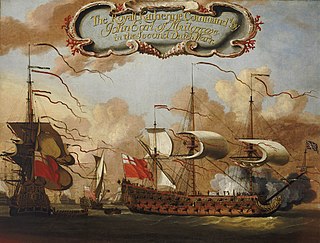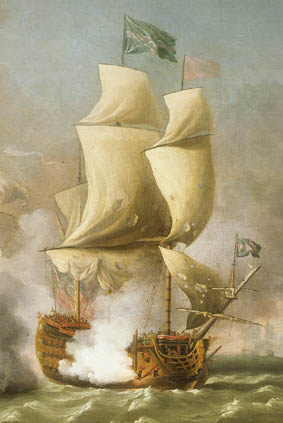HMS Ocean was a 98-gun second-rate ship of the line of the Royal Navy, launched from Woolwich Dockyard on 24 October 1805. She was the only ship built to her draught, and designed by Sir John Henslow.
Eleven ships and a shore establishment of the Royal Navy have been named HMS Medway, after the River Medway.
HMS Vanguard was a 40-gun ship of the English Royal Navy, launched in 1631 at Woolwich, and was the second vessel to bear the name. Officially she was rebuilt from the first Vanguard, but likely only shared some of the timber and fittings from the previous ship. By 1660, her armament had been increased to 56 guns.

HMS Royal Katherine was an 84-gun full-rigged second-rate ship of the line of the Royal Navy, launched in 1664 at Woolwich Dockyard. Her launching was conducted by Charles II and attended by Samuel Pepys. Royal Katherine fought in both the Second and Third Anglo-Dutch Wars and afterwards, the War of the Grand Alliance before entering the dockyard at Portsmouth for rebuilding in 1702. In this rebuilding, she was upgraded to carry more guns, 90 in total, and served in the War of the Spanish Succession during which she was renamed Ramillies in honour of John Churchill's victory at the Battle of Ramillies. She was rebuilt again in 1742–3 before serving as the flagship of the ill-fated Admiral John Byng in the Seven Years' War. Ramillies was wrecked at Bolt Tail near Hope Cove on 15 February 1760.

The Dublin-class ships of the line were a class of seven 74-gun third rates, designed for the Royal Navy by Sir Thomas Slade.

The Sandwich class ships of the line were a class of three 90-gun second rates, designed for the Royal Navy by Sir Thomas Slade.

HMS Cambridge was an 80-gun third-rate ship of the line of the Royal Navy, designed by Sir Joseph Allin and built at Deptford Dockyard by Adam Hayes to the draught specified by the 1745 Establishment as amended in 1750, and launched on 21 October 1755.

HMS Medway was a 74-gun third rate ship of the line of the Royal Navy, launched on 19 November 1812 at Northfleet.

Alcide was a 64-gun ship of the line of the French Navy, launched in 1742. The captain of the vessel was Toussaint Hocquart, for the re-enforcement campaign that was sent to Canada in May 1755.
Duc d'Aquitaine was a 64-gun East Indiaman of the Compagnie des Indes, launched in 1754. On 30 May 1757, she was captured by the Royal Navy and commissioned as the third rate HMS Duc D'Aquitaine. She foundered in 1761 and was lost.
Conquestador was a 60-gun ship of the line of the Spanish Navy, launched in 1755.

The Richard was a 70-gun second-rate ship of the line of the navy of the Commonwealth of England, built by the Master Shipwright Christopher Pett at Woolwich Dockyard, and launched in 1658. She was named after Richard Cromwell, to honour his appointment as the Protector in succession to his late father Oliver Cromwell.

Dunbar was a 64-gun second rate ship of the line of the English Royal Navy, originally built for the navy of the Commonwealth of England at Deptford, and launched in 1656. Renamed HMS Henry in 1660, she served until 1682, when she was lost in an accidental fire.

HMS Medway was a 60-gun fourth rate ship of the line of the Royal Navy, launched at Sheerness Dockyard on 20 September 1693.

HMS Barfleur was a 90-gun second rate ship of the line of the Royal Navy, launched at Deptford Dockyard on 10 August 1697.

HMS Swiftsure was a 70-gun third-rate ship of the line of the Royal Navy, launched in 1755 and in active service during the Seven Years' War. After a distinguished career at sea she was decommissioned in 1763 and sold into private hands ten years later.

HMS Medway was a 60-gun fourth rate ship of the line of the Royal Navy, built to the 1733 proposals of the 1719 Establishment at Rotherhithe, and launched on 26 May 1742.

HMS Eagle was a 58-gun fourth rate ship of the line of the Royal Navy built at King's Yard in Harwich by John Barnard and launched in 1745.
HMS Assistance was a 50-gun fourth rate ship of the line of the Royal Navy, built at a private yard on the River Medway to the draught specified by the 1745 Establishment, and launched on 22 December 1747.

HMS Dunkirk was a 60-gun fourth-rate ship of the line of the Royal Navy, built by Edward Allin at Woolwich Dockyard to the draught specified by the 1745 Establishment as amended in 1750, and launched on 22 July 1754.















